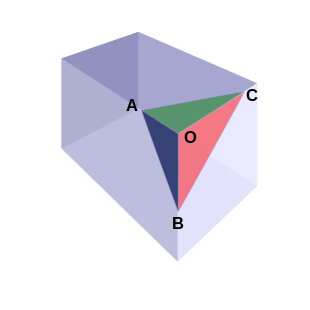De Gua's theorem

De Gua's theorem is a three-dimensional analog of the Pythagorean theorem and named for Jean Paul de Gua de Malves.
If a tetrahedron has a right-angle corner (like the corner of a cube), then the square of the area of the face opposite the right-angle corner is the sum of the squares of the areas of the other three faces.
History
Jean Paul de Gua de Malves (1713–85) published the theorem in 1783, but around the same time a slightly more general version was published by another French mathematician, Tinseau d'Amondans (1746–1818), as well. However the theorem had been known much earlier to Johann Faulhaber (1580–1635) and René Descartes (1596–1650).[1][2]
Generalizations
The Pythagorean theorem and de Gua's theorem are special cases (n = 2, 3) of a general theorem about n-simplices with a right-angle corner. This, in turn, is a special case of a yet more general theorem, which can be stated as follows.[3]
Let P be a k-dimensional plane in  (so
(so  ) and let C be a compact subset of P. For any subset
) and let C be a compact subset of P. For any subset  with exactly k elements, let
with exactly k elements, let  be the orthogonal projection of C onto the linear span of
be the orthogonal projection of C onto the linear span of  , where
, where  and
and  is the standard basis for
is the standard basis for  . Then
. Then
where  is the k-dimensional volume of C and the sum is over all subsets
is the k-dimensional volume of C and the sum is over all subsets  with exactly k elements.
with exactly k elements.
This theorem is essentially the inner-product-space version of Pythagoras’ theorem applied to the kth exterior power of n-dimensional Euclidean space. De Gua's theorem and its generalisation (above) to n-simplices with right-angle corners correspond to the special case where k = n−1 and C is an (n−1)-simplex in  with vertices on the co-ordinate axes.
with vertices on the co-ordinate axes.
Notes
- ↑ Weisstein, Eric W., "de Gua's theorem", MathWorld.
- ↑ Hans-Bert Knoop: Ausgewählte Kapitel zur Geschichte der Mathematik. Lecture Notes (University of Düsseldorf), p. 55 (§ 4 Pythagoreische n-Tupel, p. 50-65) (German)
- ↑ Theorem 9 of James G. Dowty (2014). Volumes of logistic regression models with applications to model selection. arXiv:1408.0881v3 [math.ST ]
References
- Weisstein, Eric W., "de Gua's theorem", MathWorld.
- Sergio A. Alvarez: Note on an n-dimensional Pythagorean theorem, Carnegie Mellon University.
- De Gua's Theorem, Pythagorean theorem in 3-D — Graphical illustration and related properties of the tetrahedron.

